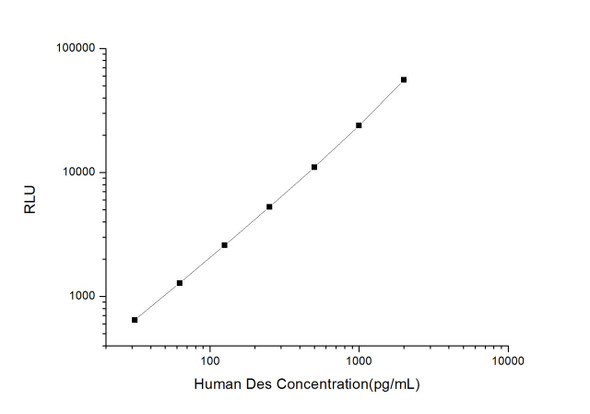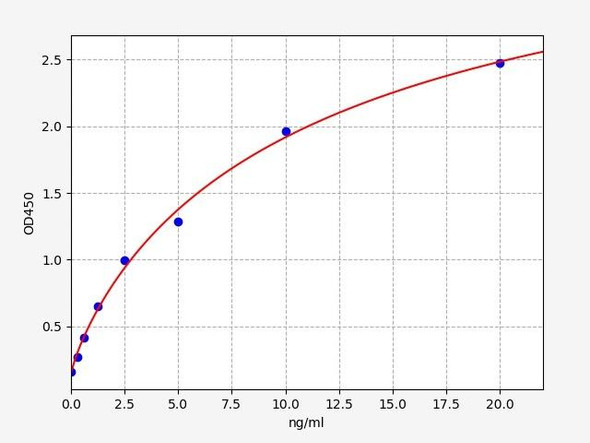Rat Signaling ELISA Kits 2
Rat Des (Desmin) CLIA Kit (RTES00178)
- SKU:
- RTES00178
- Product Type:
- ELISA Kit
- ELISA Type:
- CLIA Kit
- Size:
- 96 Assays
- Sensitivity:
- 37.5pg/mL
- Range:
- 62.5-4000pg/mL
- ELISA Type:
- Sandwich
- Reactivity:
- Rat
- Sample Type:
- Serum, plasma and other biological fluids
Description
| Assay type: | Sandwich |
| Format: | 96T |
| Assay time: | 4.5h |
| Reactivity: | Rat |
| Detection method: | Chemiluminescence |
| Detection range: | 62.50-4000 pg/mL |
| Sensitivity: | 37.50 pg/mL |
| Sample volume: | 100µL |
| Sample type: | Serum, plasma and other biological fluids |
| Repeatability: | CV < 15% |
| Specificity: | This kit recognizes Rat Des in samples. No significant cross-reactivity or interference between Rat Des and analogues was observed. |
This kit uses Sandwich-CLIA as the method. The micro CLIA plate provided in this kit has been pre-coated with an antibody specific to Rat Des. Standards or samples are added to the appropriate micro CLIA plate wells and combined with the specific antibody. Then a biotinylated detection antibody specific for Rat Des and Avidin-Horseradish Peroxidase (HRP) conjugate are added to each micro plate well successively and incubated. Free components are washed away. The substrate solution is added to each well. Only those wells that contain Rat Des, biotinylated detection antibody and Avidin-HRP conjugate will appear fluorescence. The Relative light unit (RLU) value is measured spectrophotometrically by the Chemiluminescence immunoassay analyzer. The RLU value is positively associated with the concentration of Rat Des. The concentration of Rat Des in the samples can be calculated by comparing the RLU of the samples to the standard curve.
| UniProt Protein Function: | Muscle-specific type III intermediate filament essential for proper muscular structure and function. Plays a crucial role in maintaining the structure of sarcomeres, inter-connecting the Z-disks and forming the myofibrils, linking them not only to the sarcolemmal cytoskeleton, but also to the nucleus and mitochondria, thus providing strength for the muscle fiber during activity. In adult striated muscle they form a fibrous network connecting myofibrils to each other and to the plasma membrane from the periphery of the Z-line structures (PubMed:25394388). May act as a sarcomeric microtubule-anchoring protein: specifically associates with detyrosinated tubulin-alpha chains, leading to buckled microtubules and mechanical resistance to contraction (PubMed:27102488). Contributes to the transcriptional regulation of the NKX2-5 gene in cardiac progenitor cells during a short period of cardiomyogenesis and in cardiac side population stem cells in the adult. Plays a role in maintaining an optimal conformation of nebulette (NEB) on heart muscle sarcomeres to bind and recruit cardiac alpha-actin (PubMed:27733623). |
| NCBI Summary: | This gene encodes a muscle-specific class III intermediate filament. Homopolymers of this protein form a stable intracytoplasmic filamentous network connecting myofibrils to each other and to the plasma membrane and are essential for maintaining the strength and integrity of skeletal, cardiac and smooth muscle fibers. Mutations in this gene affect assembly of intermediate filaments. Mice lacking this gene are able to develop and reproduce but exhibit abnormal muscle fibers. Mutations in the human gene are associated with myofibrillar myopathy, dilated cardiomyopathy, neurogenic scapuloperoneal syndrome and autosomal recessive limb-girdle muscular dystrophy, type 2R. [provided by RefSeq, Jan 2014] |
| UniProt Code: | P48675 |
| NCBI GenInfo Identifier: | 33563250 |
| NCBI Gene ID: | 13346 |
| NCBI Accession: | NP_034173. 1 |
| UniProt Secondary Accession: | P48675,P48675, |
| UniProt Related Accession: | P31001 |
| Molecular Weight: | Calculated: 54kDaObserved: 55kDa |
| NCBI Full Name: | desmin |
| NCBI Synonym Full Names: | desmin |
| NCBI Official Symbol: | Des |
| NCBI Protein Information: | desmin |
| UniProt Protein Name: | Desmin |
| Protein Family: | Desmin |
| UniProt Gene Name: | Des |
As the RLU values of the standard curve may vary according to the conditions of the actual assay performance (e. g. operator, pipetting technique, washing technique or temperature effects), the operator should establish a standard curve for each test. Typical standard curve and data is provided below for reference only.
| Concentration (pg/mL) | RLU | Average | Corrected |
| 4000 | 53953 64209 | 59081 | 59046 |
| 2000 | 25256 30462 | 27859 | 27824 |
| 1000 | 13971 12997 | 13484 | 13449 |
| 500 | 6204 7006 | 6605 | 6570 |
| 250 | 3403 3083 | 3243 | 3208 |
| 125 | 1702 1460 | 1581 | 1546 |
| 62.50 | 715 795 | 755 | 720 |
| 0 | 34 36 | 35 | -- |
Precision
Intra-assay Precision (Precision within an assay): 3 samples with low, mid range and high level Rat Des were tested 20 times on one plate, respectively.
Inter-assay Precision (Precision between assays): 3 samples with low, mid range and high level Rat Des were tested on 3 different plates, 20 replicates in each plate.
| Intra-assay Precision | Inter-assay Precision | |||||
| Sample | 1 | 2 | 3 | 1 | 2 | 3 |
| n | 20 | 20 | 20 | 20 | 20 | 20 |
| Mean (pg/mL) | 210.59 | 378.75 | 1758.20 | 201.91 | 374.39 | 1617.35 |
| Standard deviation | 26.26 | 36.93 | 144.00 | 25.62 | 35.04 | 151.71 |
| C V (%) | 12.47 | 9.75 | 8.19 | 12.69 | 9.36 | 9.38 |
Recovery
The recovery of Rat Des spiked at three different levels in samples throughout the range of the assay was evaluated in various matrices.
| Sample Type | Range (%) | Average Recovery (%) |
| Serum (n=5) | 95-108 | 102 |
| EDTA plasma (n=5) | 90-104 | 95 |
| Cell culture media (n=5) | 90-104 | 98 |
Linearity
Samples were spiked with high concentrations of Rat Des and diluted with Reference Standard & Sample Diluent to produce samples with values within the range of the assay.
| Serum (n=5) | EDTA plasma (n=5) | Cell culture media (n=5) | ||
| 1:2 | Range (%) | 95-109 | 100-112 | 103-115 |
| Average (%) | 100 | 106 | 109 | |
| 1:4 | Range (%) | 100-118 | 103-120 | 92-106 |
| Average (%) | 108 | 110 | 99 | |
| 1:8 | Range (%) | 100-116 | 99-113 | 92-105 |
| Average (%) | 108 | 106 | 97 | |
| 1:16 | Range (%) | 100-115 | 96-109 | 101-116 |
| Average (%) | 107 | 102 | 108 |
An unopened kit can be stored at 4°C for 1 month. If the kit is not used within 1 month, store the items separately according to the following conditions once the kit is received.
| Item | Specifications | Storage |
| Micro CLIA Plate(Dismountable) | 8 wells ×12 strips | -20°C, 6 months |
| Reference Standard | 2 vials | |
| Concentrated Biotinylated Detection Ab (100×) | 1 vial, 120 µL | |
| Concentrated HRP Conjugate (100×) | 1 vial, 120 µL | -20°C(shading light), 6 months |
| Reference Standard & Sample Diluent | 1 vial, 20 mL | 4°C, 6 months |
| Biotinylated Detection Ab Diluent | 1 vial, 14 mL | |
| HRP Conjugate Diluent | 1 vial, 14 mL | |
| Concentrated Wash Buffer (25×) | 1 vial, 30 mL | |
| Substrate Reagent A | 1 vial, 5 mL | 4°C (shading light) |
| Substrate Reagent B | 1 vial, 5 mL | 4°C (shading light) |
| Plate Sealer | 5 pieces | |
| Product Description | 1 copy | |
| Certificate of Analysis | 1 copy |
- Set standard, test sample and control (zero) wells on the pre-coated plate and record theirpositions. It is recommended to measure each standard and sample in duplicate. Note: addall solutions to the bottom of the plate wells while avoiding contact with the well walls. Ensuresolutions do not foam when adding to the wells.
- Aliquot 100µl of standard solutions into the standard wells.
- Add 100µl of Sample / Standard dilution buffer into the control (zero) well.
- Add 100µl of properly diluted sample (serum, plasma, tissue homogenates and otherbiological fluids. ) into test sample wells.
- Cover the plate with the sealer provided in the kit and incubate for 90 min at 37°C.
- Aspirate the liquid from each well, do not wash. Immediately add 100µL of BiotinylatedDetection Ab working solution to each well. Cover the plate with a plate seal and gently mix. Incubate for 1 hour at 37°C.
- Aspirate or decant the solution from the plate and add 350µL of wash buffer to each welland incubate for 1-2 minutes at room temperature. Aspirate the solution from each well andclap the plate on absorbent filter paper to dry. Repeat this process 3 times. Note: a microplatewasher can be used in this step and other wash steps.
- Add 100µL of HRP Conjugate working solution to each well. Cover with a plate seal andincubate for 30 min at 37°C.
- Aspirate or decant the solution from each well. Repeat the wash process for five times asconducted in step 7.
- Add 100µL of Substrate mixture solution to each well. Cover with a new plate seal andincubate for no more than 5 min at 37°C. Protect the plate from light.
- Determine the RLU value of each well immediately.






